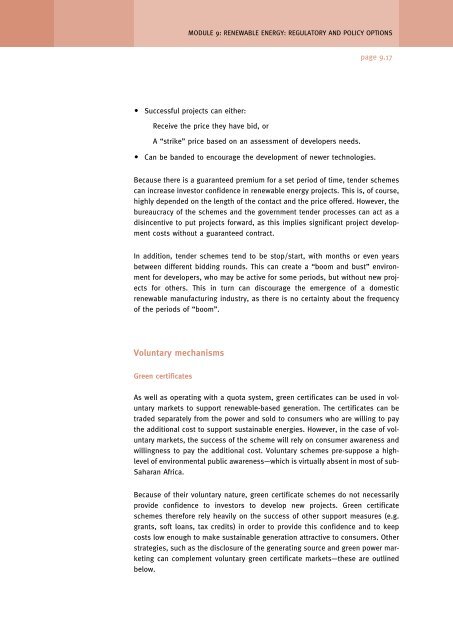Regulatory and policy options to encourage development of ...
Regulatory and policy options to encourage development of ...
Regulatory and policy options to encourage development of ...
- No tags were found...
You also want an ePaper? Increase the reach of your titles
YUMPU automatically turns print PDFs into web optimized ePapers that Google loves.
MODULE 9: RENEWABLE ENERGY: REGULATORY AND POLICY OPTIONSpage 9.17 Successful projects can either:Receive the price they have bid, orA “strike” price based on an assessment <strong>of</strong> developers needs. Can be b<strong>and</strong>ed <strong>to</strong> <strong>encourage</strong> the <strong>development</strong> <strong>of</strong> newer technologies.Because there is a guaranteed premium for a set period <strong>of</strong> time, tender schemescan increase inves<strong>to</strong>r confidence in renewable energy projects. This is, <strong>of</strong> course,highly depended on the length <strong>of</strong> the contact <strong>and</strong> the price <strong>of</strong>fered. However, thebureaucracy <strong>of</strong> the schemes <strong>and</strong> the government tender processes can act as adisincentive <strong>to</strong> put projects forward, as this implies significant project <strong>development</strong>costs without a guaranteed contract.In addition, tender schemes tend <strong>to</strong> be s<strong>to</strong>p/start, with months or even yearsbetween different bidding rounds. This can create a “boom <strong>and</strong> bust” environmentfor developers, who may be active for some periods, but without new projectsfor others. This in turn can discourage the emergence <strong>of</strong> a domesticrenewable manufacturing industry, as there is no certainty about the frequency<strong>of</strong> the periods <strong>of</strong> “boom”.Voluntary mechanismsGreen certificatesAs well as operating with a quota system, green certificates can be used in voluntarymarkets <strong>to</strong> support renewable-based generation. The certificates can betraded separately from the power <strong>and</strong> sold <strong>to</strong> consumers who are willing <strong>to</strong> paythe additional cost <strong>to</strong> support sustainable energies. However, in the case <strong>of</strong> voluntarymarkets, the success <strong>of</strong> the scheme will rely on consumer awareness <strong>and</strong>willingness <strong>to</strong> pay the additional cost. Voluntary schemes pre-suppose a highlevel<strong>of</strong> environmental public awareness—which is virtually absent in most <strong>of</strong> sub-Saharan Africa.Because <strong>of</strong> their voluntary nature, green certificate schemes do not necessarilyprovide confidence <strong>to</strong> inves<strong>to</strong>rs <strong>to</strong> develop new projects. Green certificateschemes therefore rely heavily on the success <strong>of</strong> other support measures (e.g.grants, s<strong>of</strong>t loans, tax credits) in order <strong>to</strong> provide this confidence <strong>and</strong> <strong>to</strong> keepcosts low enough <strong>to</strong> make sustainable generation attractive <strong>to</strong> consumers. Otherstrategies, such as the disclosure <strong>of</strong> the generating source <strong>and</strong> green power marketingcan complement voluntary green certificate markets—these are outlinedbelow.










